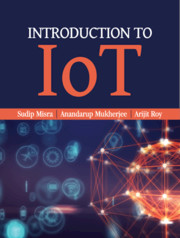14 - Healthcare IoT
Published online by Cambridge University Press: 09 January 2021
Summary
Learning Outcomes
After reading this chapter, the reader will be able to:
Relate to the applicability of IoT in real-life scenarios
List the salient features of healthcare IoT
Understand and examine the basic implementation aspects of healthcare IoT
Understand the requirements, challenges, and advantages in implementing IoT in healthcare
Relate to the appropriate use of various IoT technologies through a real-life use case of healthcare IoT system
Introduction
Internet of Things (IoT) has resulted in the development and emergence of a variety of technologies that has had a huge impact on the medical field, especially wearable healthcare. The salient features of IoT encourage researchers and industries to develop new IoT-based technologies for healthcare. These technologies have given rise to small, power-efficient, health monitoring and diagnostic systems. Consequently, the development of numerous healthcare technologies and systems has rapidly increased over the last few years. Currently, various IoT-enabled healthcare devices are in wide use around the globe for diagnosing human diseases, monitoring human health conditions, caring/monitoring for elders, children, and even infants. Moreover, IoT-based healthcare systems and services help to increase the quality of life for common human beings; in fact, it has a promising scope of revolutionizing healthcare in developing nations. IoT-based healthcare devices provide access and knowledge about human physiological conditions through hand held devices. With this development, users can be aware of the risks in acquiring various diseases and take necessary precautions to avoid preventable diseases. The basic skeleton of an IoT-based healthcare system is very similar to the conventional IoT architectures. However, for IoT-based healthcare services, the sensors are specifically designed to measure and quantify different physiological conditions of its users/patients. A typical architecture for healthcare IoT is shown in Figure 14.1. We divide the architecture into four layers. The detailed description of these layers are as follows:
(i) Layer 1: We have already explained in previous chapters that sensors are one of the key enablers of IoT infrastructure. Layer 1 contains different physiological sensors that are placed on the human body. These sensors collect the values of various physiological parameters. The physiological data are analyzed to extract meaningful information.
- Type
- Chapter
- Information
- Introduction to IoT , pp. 293 - 305Publisher: Cambridge University PressPrint publication year: 2021

